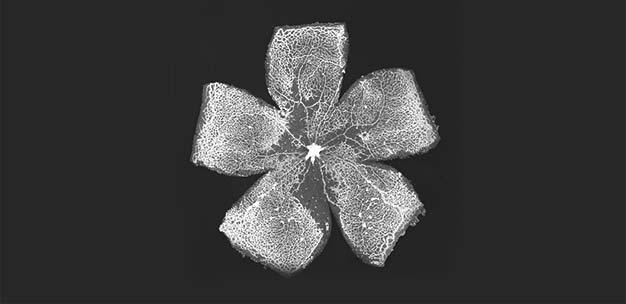Keio scientists discover a possible target for controlling pathological growth of new blood vessels without hindering healthy processes
Published online 6 March 2015

The retina of mice lacking a key blood vessel enzyme showed almost no production of tumor-like vessels during restricted oxygen flow.
Reproduced, with permission, from Ref. 1 © 2012 Y. Okuno et al.
The growth of new blood vessels in tumors has long been a tempting target for cancer treatments. But scientists testing anti-angiogenic agents such as vascular endothelial growth factor (VEGF) inhibitors face a problem: how to inhibit pathological angiogenesis associated with tumors without hindering the healthy growth of blood vessels in the rest of the body. Yoshiaki Kubota from the Laboratory of Vascular Biology at Keio University explains: "The VEGF blockade not only targets tumor vessels but it also damages normal healthy vessels."
In 2012, his team made an unexpected discovery that revealed a possible way to target pathological blood vessel growth without harming healthy blood vessels1. Their finding has revived the prospects of treating cancer and other diseases such as macular degeneration in this way.
Kubota's team focused on an enzyme called ataxia telangiectasia mutated (ATM) kinase, which plays a key role in the development and maintenance of blood vessels. Mutations in the ATM gene in humans are linked with ataxia telangiectasia, an inherited disease whose features include dilated and leaky blood vessels.
To understand the function of ATM in normal and pathological blood vessels, Kubota's team induced ischemic retinopathy by limiting oxygen flow to the retina. The resulting accumulation of reactive oxygen species activated Atm expression in immature blood vessels that are similar to tumor vessels. Importantly, the hypoxic conditions did not affect Atm production in surrounding non-pathological blood vessels.
When the researchers repeated this same process in mice engineered to lack endothelial Atm, they saw none of the pathological retinal angiogenesis apparent in the normal mice (see image), showing clearly that Atm played a pivotal role in the growth of these destructive blood vessels.
The researchers then tested the impact of the relationship between Atm and angiogenesis in a mouse model of melanoma, and found similarly that angiogenesis and tumor growth were inhibited in mice lacking endothelial-specific Atm. In addition, Atm deficiency enhanced the anti-angiogenic action of VEGF inhibitors.
"Most importantly, the disruption of Atm signaling prevented pathological neovasculogenesis without affecting normal vascular regeneration," commented Bethany Kerr and Tatiana Byzova in an article in Nature Medicine2. "Thus, Atm activation could be an ideal target for new therapies to combat pathological angiogenesis in a variety of diseases."
Because ATM kinase is associated with a well-known cellular mechanism for managing the damage caused by free radicals ― known as the DNA damage response pathway ― the researchers first suspected that loss of this pathway may have been responsible for the lack of pathogenic blood vessel growth in the knockout mice. But on looking more closely, they found that a completely different pathway was implicated, one involving activation of the stress-associated kinase p38.
"Endothelial metabolism is now being focused on worldwide as a target for anti-angiogenic therapy," Kubota says. His 2012 paper is cited as a pioneering study in the field, and his lab has been inundated with requests for the mouse lines used in the paper, including the Atm knockout mice, by researchers intent on studying the exciting new cancer target.
References
- Okuno, Y., Nakamura-Ishizu, A., Otsu, K., Suda, T. & Kubota, Y. Pathological neoangiogenesis depends on oxidative stress regulation by ATM. Nature Medicine 8, 1208-1216 (2012). | article
- Kerr, B. A. & Byzova, T. V. The dark side of the oxidative force in angiogenesis. Nature Medicine 18, 1184-1185 (2012). | article